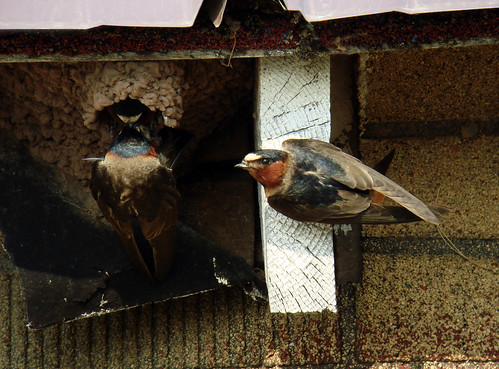 |
| Cliff Swallows |
The mission, founded in 1776 by Spanish Catholics of the Franciscan order, has had a fascinating history. An 1812 earthquake damaged much of the structures. In 1841, Governor Juan Alvarado declared the Mission a secular Mexican town, granting the few remaining residents rights of ownership or use of the land. In 1845, two Englishmen bought the Mission property under questionable circumstances. A smallpox epidemic in 1862 killed most of the native peoples of the area, and Abraham Lincoln signed a proclamation on March 18, 1865—the month before he died—restoring ownership of the mission to the Catholic Church.
 |
| Mission San Juan Capistrano, photochrom print by William Henry Jackson c. 1899 |
It’s hard to say when people first associated the Mission with Cliff Swallows, but a play by John Steven McGroarty titled The Mission Play, written in 1911, ends “amid the broken and deserted walls of Mission San Juan Capistrano (the Mission of the Swallow).” The Cliff Swallows may have started nesting on the structure as soon as it was built. According to legend, the birds first started nesting at the Mission when an irate innkeeper outside the Mission began destroying their mud nests, but the swallows were almost certainly attracted to the structure anyway because the Mission walls conspicuously rose above the landscape, and its location near two rivers made it an ideal location for obtaining both the mud necessary for building their little adobe nests and a constant supply of the insects for feeding adults and their young. The walls also provided protection against the elements.
In 1915, an article in Overland Monthly, a California magazine, told the story of the birds' annual habit of nesting beneath the Mission's eaves and archways, and made the swallows the "signature icon" of the Mission. The pastor of the Mission at the time, a Father O'Sullivan, capitalized on the swallows to generate public interest in restoring the Mission. A popular tale was that the swallows (las golondrinas in Spanish) flew over the Atlantic Ocean to Jerusalem each winter, carrying small twigs on which they could rest atop the water along the way.
On March 13, 1939 (six days before St. Joseph's Feast Day), a popular radio program was broadcast live from the Mission grounds, announcing the swallows' arrival. Composer Leon René was so inspired by the event that he wrote the song "When the Swallows Come Back to Capistrano," which became a hit released by many popular singers. A glassed-off room in the Mission was designated in the composer’s honor and displays the upright piano on which he composed the tune, the reception desk from his office and several copies of the song's sheet music and other pieces of furniture, all donated by René's family.
During all the time that the swallows were nesting at the Mission, they certainly never thought about St. Joseph nor about returning specifically on his feast day. But bird migration does have natural rhythms, and the birds most certainly tended to return by about March 19—as long as people could carefully avert their eyes to avoid noticing them before that date, they could count on their return on St. Joseph’s feast day.
There is something so deeply pleasurable in counting on the rhythms of nature that people all over the country loved hearing about the swallows’ annual return. As Rachel Carson wrote, “There is symbolic as well as actual beauty in the migration of birds. There is something infinitely healing in the repeated refrains of nature--the assurance that dawn comes after night, and spring after the winter.”
By the 1980s, the numbers of swallows returning were diminishing. At some point in the 1990s, I remember watching a CBS news story reported by Dan Rather about the birds’ return, only the cameras weren’t focused on swallows at all, but on swifts.
 |
| Cliff Swallow population trend in California, from USGS Breeding Bird Survey |
Now few if any swallows nest on the Mission each year. Much of the loss is due to development. Optimists claim that now there are many more structures for the birds to use. But the truth is, Cliff Swallows are declining significantly throughout California. Pollution and overuse of the limited water resources have destroyed populations of mayflies and other valuable insects essential for fueling their migration and feeding families during the breeding season. Extended drought conditions exacerbated by overuse of water may also have decreased the supply of useful mud for building.
It mystifies me how people who treasure our nation’s human history and traditions don’t seem to see how much we lose in terms of human values as well as natural ones when our most beloved species decline. We learn as children that people eventually die, buildings and businesses and whole cultures and civilizations eventually fall apart, but the one thing we can count on—the one thing that gives us our very concept of permanence, or "forever"—is nature.
Watching the skies for swallows on St. Joseph's Feast Day may be at heart romantic silliness, but our trust in the future is fundamentally compromised when we sell out the permanence of nature’s rhythms for quarterly returns on our 401-Ks. I hope we figure that out before our society crumbles like the Mission’s walls.